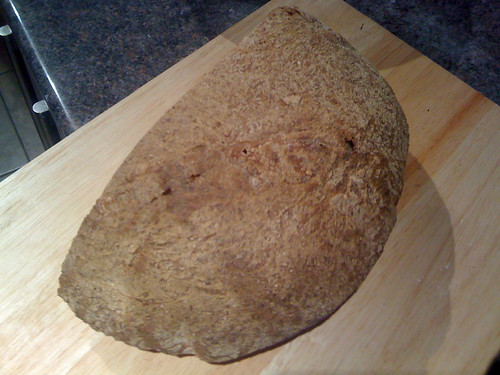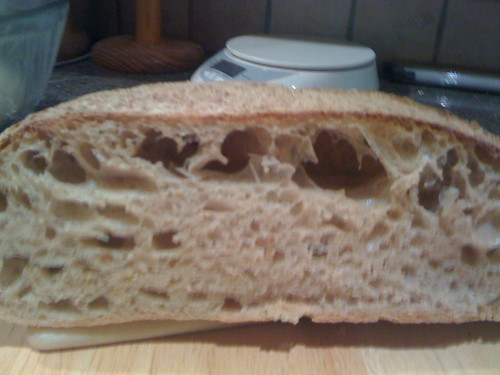This was the style of bread that I started off trying to make. Eventually, I gave it up because my loaves just wen't turning out good. Oh sure, they were edible. Nothing you'd call bad. But they just didn't have that 'great' quality either. Given that I'd nailed that with my miche, I thought I'd take another shot at it.
The recipe that I was using comes from Andrew Lansley's book, Bread Matters. I like this book a lot. It's British, for one thing. It's aimed at the home baker rather than the professional. And he's passionate about his bread. So yeah, I do like this book a lot.
Anyway, I had a go at his recipe yesterday. Here's the outcome:
And here's a look at the crumb:
As usual, the taste of the bread is fine. But I'd like to be able to solve some of the aesthetic problems.
Lets look at the recipe
Stage 1: refresh the levain
160 grms wheat levain starter
50 grms stoneground wholemeal flour
150 grms strong white flour
Mix at about 27c and leave for 4 hours
Final dough
100 grms stoneground wholemeal flour
300 grms strong white flour
7 grms sea salt (I used 10 and still didn't think it was enough)
300 grms water
300 grms production levain.
Mix all the ingredients except the production levain into a dough and knead for about 10 mins -- until you start to feel the gluten.
Then combine the production levain and work it well into the dough. At this stage you can add more water or flour, depending on how tight or slack you want the dough..
Even at the end of kneading, the dough should still stick to your hands and worktop.
When the dough is well kneaded, wet a section of worktop and the rim of a glass bowl. Cover the dough with your bowl and let it rest on the worktop for an hour..
After an hour, stretch and fold the dough, starting with the furthest away edge and folding into the centre.
Then the front, and into the centre. And the sides.
You'll notice the dough tighten up and form a shaped boule. Dredge the dough in wholemeal flour and place, seam side up into a well floured banneton, then let it prove for around 4 hours.
When it's proved, turn it onto your peel, slash the dough and slip it into a preheated oven at about 220c. After 10 minutes, turn the heat down to 200c for a further 30 minutes until the loaf has a good strong coloured crust.
Well, everything went pretty much as it said on the tin. It's a very wet dough. My calculation makes it 73% hydration, and so the dough is very soft, very wet and very difficult to handle and work. This makes it hard to get good definition in your slashes, when you turn it out of the banneton, it doesn't hold it's shape at all -- simply drops to a pancake. When it's on the second prove, it still feels like wet dough -- even three or four hours in.
As you can see from the picture, although there is random holes, there are a large number of big holes at the top of the dough rather than distributed evenly throughout. Presumably that is because a with dough as wet as this one, all the air bubbles will rise to the top.
Although it was just a 73% hydration dough, it felt more like an 80% hydration. It was like working with a ciabatta dough or something. When I look at people working with wet doughs on YouTube, they've got a dough that they're able to work with.
Here's an example of the kind of wet but workable dough I'm trying to shoot for:
See that skin she gets? I just don't get that. My dough is still sticky -- even after the prove. I try to shape it, but it's just like I'm back to kneading again, the dough is that wet and sticky. The only way I can work it is by using wet hands/wet bench scrapers, etc.
So, does anyone have any idea what's going wrong here? Do I just need to drop the dough back to a dryer hydration? If I'm working with just white flour, that boule shapes pretty well identically to mine at 67% hydration. Am I underkneading? Overkneading? Something else?
I'd be really grateful for any hints as to what I'm doing wrong here Any thoughts, guys?


Andrew Lansley baking bread? :)
ReplyDeleteYou have a flying crust - I'd google that and see what you can do.
French flour tends to need less water than the flour we're used to here (I'm assuming that you're in the UK), so perhaps you can reduce the water a bit, maybe 10% and see how you get on?